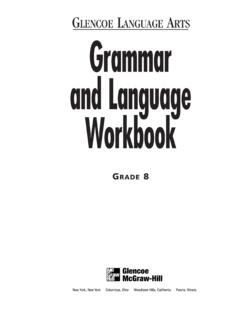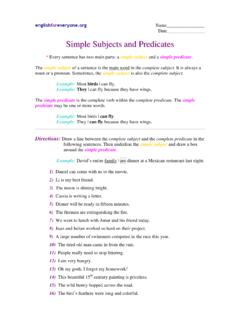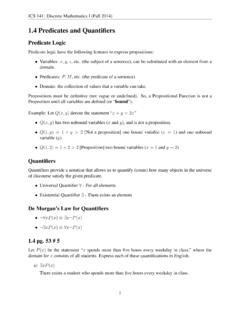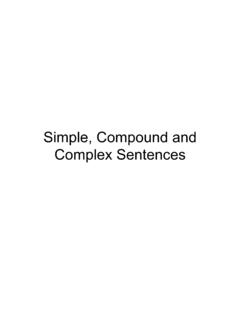Transcription of Symbolic Logic - University of California, Los Angeles
1 An Introduction to Symbolic Logic Copyright 2006-09 by Terence Parsons all rights reserved Copyrighted material Introduction -- 2 To the Instructor: The system of Logic used here is essentially that of Kalish, Montague and Mar, Harcourt Brace Jovanovich, 1992. The principle difference is that written justifications are required for boxing and canceling: 'dd' for a direct derivation, 'id' for an indirect derivation, etc. This text was written to be used along with the UCLA Logic2K software program, but that program is never mentioned, and the text can be used independently (although you would want to supplement the exercises). The system of notation is the same as KK&M except that the signs ' ' and ' ' are used for the quantifiers, and name and operation symbols are small letters.
2 The exercises are all new. Chapters 1-3 cover pretty much the same material as KM&M except that the rule allowing for the use of previously proved theorems is now in chapter 2, immediately following the section on theorems. Chapters 4-6 include invalidity problems with infinite universes, where one specifies the interpretation of notation "by description"; "R(xy): x y". The technique of false relativizations of arithmetical translations is not covered. Chapter 4 covers material from KK&M chapter IV, but without operation symbols. Chapter 4 also includes material from KK&M chapter VII, namely interchange of equivalents, biconditional derivations, monadic sentences without quantifier overlay, and prenex normal form.
3 Chapter 5 covers identity and operation symbols. Chapter 6 covers Fregean definite descriptions, as in KK&M chapter VI. Copyrighted material Introduction -- 3 CONTENTS Chapter One Sentential Logic with 'if' and 'not' 1 Symbolic NOTATION 2 MEANINGS OF THE Symbolic NOTATION 3 SYMBOLIZATION: TRANSLATING COMPLEX SENTENCES INTO Symbolic NOTATION 4 RULES 5 DIRECT DERIVATIONS 6 CONDITIONAL DERIVATIONS 7 INDIRECT DERIVATIONS 8 SUBDERIVATIONS 9 SHORTCUTS 10 STRATEGY HINTS FOR DERIVATIONS 11 THEOREMS 12 USING PREVIOUSLY PROVED THEOREMS IN DERIVATIONS Chapter Two Sentential Logic with 'and', 'or', if-and-only-if' 1 Symbolic NOTATION 2 ENGLISH EQUIVALENTS OF THE CONNECTIVES 3 COMPLEX SENTENCES 4 RULES 5 SOME DERIVATIONS USING RULES S, ADJ, CB 6 ABBREVIATING DERIVATIONS 7 USING THEOREMS AS RULES 8 DERIVED RULES 9 OFFICIAL CONDITIONS FOR DERIVATIONS 10 TRUTH TABLES AND TAUTOLOGIES 11 TAUTOLOGICAL IMPLICATION Chapter Three Individual constants, predicates .
4 Variables and Quantifiers 1 INDIVIDUAL CONSTANTS AND predicates 2 QUANTIFIERS, VARIABLES, AND FORMULAS 3 SCOPE AND BINDING 4 MEANINGS OF THE QUANTIFIERS 5 SYMBOLIZING SENTENCES WITH QUANTIFIERS 6 DERIVATIONS WITH QUANTIFIERS 7 UNIVERSAL DERIVATIONS 8 SOME DERIVATIONS 9 DERIVED RULES 10 INVALIDITIES 11 EXPANSIONS Copyrighted material Introduction -- 4 Chapter Four Many-Place predicates 1 MANY-PLACE predicates 2 SYMBOLIZING SENTENCES USING MANY-PLACE predicates 3 DERIVATIONS 4 THE RULE "INTERCHANGE OF EQUIVALENTS" 5 BICONDITIONAL DERIVATIONS 6 SENTENCES WITHOUT OVERLAY OF QUANTIFIERS 7 PRENEX NORMAL FORMS 8 SOME THEOREMS 9 SHOWING INVALIDITY Chapter Five Identity and Operation Symbols 1 IDENTITY 2 AT LEAST AND AT MOST, EXACTLY.
5 AND ONLY 3 DERIVATIONAL RULES FOR IDENTITY 4 INVALIDITIES WITH IDENTITY 5 OPERATION SYMBOLS 6 DERIVATIONS WITH COMPLEX TERMS 7 INVALID ARGUMENTS WITH OPERATION SYMBOLS 8 COUNTER-EXAMPLES WITH INFINITE UNIVERSES Chapter Six Definite Descriptions 1 DEFINITE DESCRIPTIONS 2 SYMBOLIZING SENTENCES WITH DEFINITE DESCRIPTIONS 3 DERIVATIONAL RULES FOR DEFINITE DESCRIPTIONS: PROPER DESCRIPTIONS 4 SYMBOLIZING ORDINARY LANGUAGE 5 DERIVATIONAL RULES FOR DEFINITE DESCRIPTIONS: IMPROPER DESCRIPTIONS 6 INVALIDITIES WITH DEFINITE DESCRIPTIONS 7 UNIVERSAL DERIVATIONS 8 COUNTER-EXAMPLES WITH INFINITE UNIVERSES Introduction - Answers to the Exercises Copyrighted material Introduction -- 5 Introduction Logic is concerned with arguments, good and bad.
6 With the docile and the reasonable, arguments are sometimes useful in settling disputes. With the reasonable, this utility attaches only to good arguments. It is the logician's business to serve the reasonable. Therefore, in the realm of arguments, it is the logician who distinguishes good from bad. Kalish & Montague 1964 p. 1 1 DEDUCTIVE REASONING Logic is the study of correct reasoning. It is not a study of how this reasoning originates, or what its effects are in persuading people; it is rather a study of what it is that makes some reasoning "correct" as opposed to "incorrect". If you have ever found yourself or someone else making a mistake in reasoning, then this is an example of someone being taken in by incorrect reasoning, and you have some idea of what we mean by correct reasoning: it is reasoning that contains no mistakes, persuasive or otherwise.
7 It is typical in Logic to divide reasoning into two kinds: deductive and inductive, or, roughly, "airtight" and "merely probable". Here is an example of probable reasoning. You have just been told that Mary bought a new car, and you say to yourself: In the past, Mary always bought big cars. Big cars are usually gas-guzzlers. So she (probably) now has a gas-guzzler. Your conclusion, that Mary has a gas-guzzler, is not one that you think of as following logically from the information that you have; it is merely a probable inference. Inductive Logic , which is the study of probable reasoning, is not very well understood at present. There are certain rather special cases that are well developed, such as the application of the probability calculus to gambling games.
8 But a general study has not met with great success. This is not a book about probable reasoning, but if you are interested in it, this is the place to start. This is because most studies of Inductive Logic take for granted that you are already familiar with Deductive Logic -- the Logic of "airtight" reasoning -- which forms the subject matter of this book. So you have to start here anyway. Here is an example of deductive reasoning. Suppose that you recall reading that either James Polk or Eli Whitney was a president of the United States, but you can't remember which one. Some knowledgeable person tells you that Eli Whitney was never president (he was a famous inventor). Based on this information you conclude that Polk was a president.
9 The information that you have, and the conclusion that you draw from this information, is: Either Polk or Whitney was a president. Whitney was not a president. So Polk was a president. Let us compare this reasoning with the other reasoning given above. They both have one thing in common: the information that you start with is not known for certain. In the first example, you have only been told that Mary bought a new car, and this may be a lie or a mistake. Likewise, you may be misremembering her past preferences for car sizes. The same is true in the second reasoning: you were only told that Eli Whitney was not president -- by someone else or by a history book -- and your memory that either Polk or Whitney was a president may also be inaccurate.
10 In both cases the information that you start with is not known for certain, and so in this sense your conclusions are only probable. Reasoning is always reasoning from some claims, called the premises of the reasoning, to some further claim, called the conclusion. If the premises are not known for certain, then no matter how good the reasoning is, the conclusion will not be known for certain either. (There are certain special exceptions to this; see the exercises Introduction - Answers to the Exercises Copyrighted material Introduction -- 6 below.) There is, however, a difference in the nature of the inferences in the two cases.



